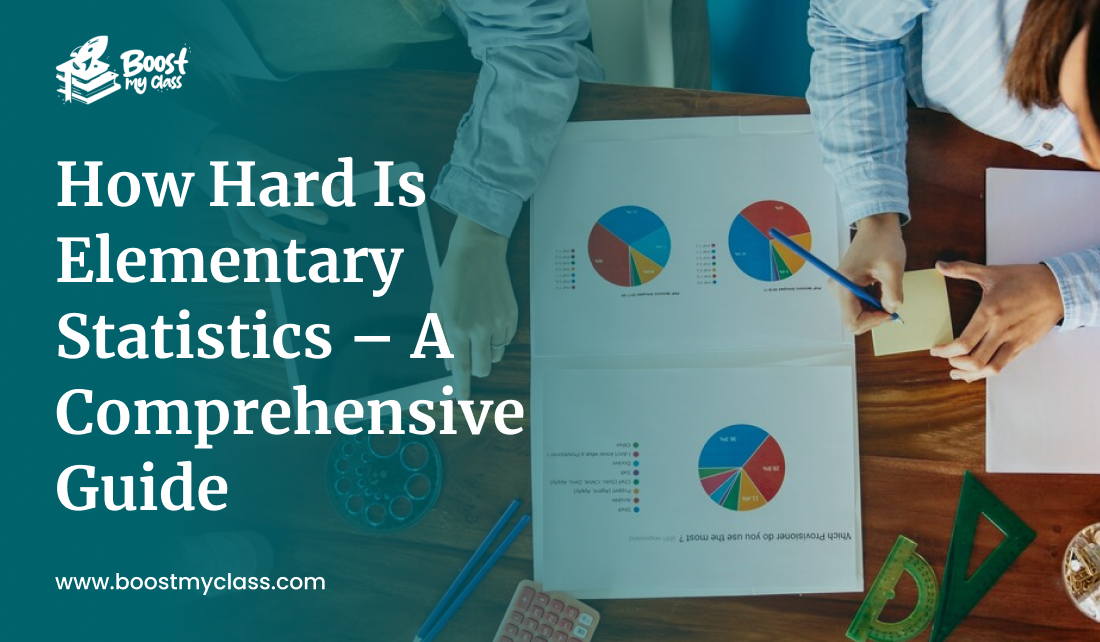How Hard Is Elementary Statistics – A Comprehensive Guide

Today you’re going to know exactly how hard elementary statistics is.
In this latest guide, we’ll cover:
- How difficult is Elementary statistics?
- What is Elementary Statistics?
- What does it consist of?
- How to do well in Elementary Statistics.
- Should I take it online? And many more.
So, If you want to learn more about it, you’ll love this latest guide.
So let’s get started with our key takeaways.
Key Takeaway
- Yes, elementary statistics can be very difficult but not impossible level.
- It is a branch of mathematics in which we understand information that comes in the form of numbers, graphs, tables, and tables.
- Elementary statistics consists of descriptive statistics, probability, probability distribution, correlation, and regression.
- It totally depends on your academic and career goals to take elementary statistics online.
Table of Contents
How Hard Is Elementary Statistics?
It can be very difficult but it’s not super hard. The difficulty of elementary statistics can vary from person to person, depending on your background, mathematical aptitude, and how well the subject is taught.
If you have a strong foundation in algebra, you will find elementary statistics to be relatively easy. However, if you struggle with math, you may find it to be more challenging.
Long story short, Elementary statistics, as a subject, is often considered difficult by some individuals due to its reliance on mathematical concepts and data analysis. However, its level of difficulty largely depends on one’s background, previous exposure to mathematical concepts, and the way it is taught.
Need assistance with your Online Statistics Class? Simply reach out to us.
150+ ![]()
Qualified Tutors
What Is Elementary Statistics?
Elementary statistics is a branch of mathematics that deals with collecting, interpreting, organizing, analyzing, and presenting data. It’s all about understanding information that comes in the form of numbers, tables, charts, and graphs.
Elementary statistics is often taught as a basic course in statistics, providing fundamental information for various subjects like science, business, and social sciences.
7 Subjects In Which Elementary Statistics Is A Part of Syllabus
Take My Exam because here are 7 examples of exams and areas where elementary statistics may be part of the syllabus:
- Mathematics
- Social Sciences
- Economics
- Business & Finance
- Data Science & Analytics
- Social Research
- Engineering
Need assistance with your Online Statistics Exam? Simply reach out to us.
150+ ![]()
Qualified Tutors
1) Applications Of Elementary Statistics
Elementary statistics has a large number of practical applications in various fields. Here are some key applications:
- In business, it’s used for market research, quality control, and financial analysis.
- In healthcare, it informs medical research and epidemiology.
- In social sciences, it’s used to understand human behavior through surveys and studies.
- In natural sciences, it helps for data analysis in biology, chemistry, and physics.
- In education, it provides assessment and educational research.
What Do Elementary Statistics Consist Of?
Elementary statistics consists of a set of fundamental concepts. Here are the key components of which elementary statistics consists:
1) Descriptive Statistics
It is a basic topic in elementary statistics that focuses on summarizing and describing data in a meaningful and informative way. The purpose of descriptive statistics is to simplify complicated data sets, making them easier to learn.
2) Correlation and regression
Elementary statistics introduces concepts of correlation and regression, which help analyze relationships between variables. Correlation measures the strength and direction of a relationship, while regression predicts one variable based on another.
3) Probability
Probability is a fundamental concept in statistics. It deals with the likelihood of events occurring and provides a framework for making predictions based on data.
4) Probability Distribution
Elementary statistics introduces common probability distributions, such as the normal and binomial distributions. These distributions describe how data is distributed and are often used in statistical analysis.
5) Data Visualization
The ability to create understandable graphs and charts to visualize data is an important skill. This includes histograms, scatterplots, bar charts, and more.
How To Do Well In Elementary Statistics?
Most students ask this question frequently, Here are 5 essential ways to pass elementary statistics class:
1) Ensure You Fully Understand The Basics
Don’t just learn formulas, try to understand the complete concepts. This will help you apply your knowledge to different problems. When you start with the basics it helps you develop more understanding of advanced statistical topics.
2) Don’t Be Afraid To Ask For Help
If you don’t understand anything, don’t be afraid. Take My Online Class or visit your instructor during office hours. You can also consider joining a study group.
When you ask different questions confidently it helps you to learn new things in your subject and clarify concepts.
3) Do Your Homework And Assignments
Do all your homework and assignments on time. This will help you during practice.
Statistics is a subject that requires practice.
Homework and assignments offer a platform for hands-on practice with statistical problems, calculations, and data analysis. By practicing through these problems, you gain a better understanding of the material.
4) Attend Regular Classes
Attend all your classes and pay close attention to the lectures. No matter how difficult the subject is being present and engaged is the first step to success.
5) Do Practice
Practice makes perfect. Practicing elementary statistics is very important to understanding and clarifying the concepts and techniques included.
Remember that practice is key to mastering statistics. Start with basic concepts and gradually practice your way up to more complicated problems as you build confidence in your statistical skills.
I will recommend you add these books while practicing and learning. These books explain concepts and problem-solving through examples.
- Elementary Statistics – A step-by-step approach by Allan G. Bluman.
- Modern Elementary Statistics by John E. Freund
- Elementary Statistics by Mario F. Triola
Should I Take Elementary Statistics In College?
Yes, Definitely you should take elementary statistics in college but it depends on your academic and career goals. Here are some reasons to consider when making this decision:
4 Reasons to Take Elementary Statistics In College
1) Required Courses
Some degree programs and majors may require you to take elementary statistics as part of the syllabus. Check your program’s requirements to see if it’s compulsory.
2) Prerequisite
If you plan to take more advanced courses in statistics, economics, psychology, or other subjects that involve data analysis, elementary statistics can serve as a valuable qualification, providing you with important foundational information.
3) Career Goals
If your future career goals are working with data, research, or decision-making based on data analysis (e.g., business, social sciences, healthcare), elementary statistics can be highly recommended.
4) Personal Interest
If you have a personal interest in elementary statistics and also have a good understanding of how data is analyzed and used in various subjects, taking the course can be rewarding.
3 Reasons For Not Taking Elementary Statistics In College
1) No Requirement
If your program of study and future study plans do not require elementary statistics, you might consider other math or similar classes that align better with your interests and goals.
2) Math Anxiety
If you struggle with mathematical concepts, you may find statistics harder. In such cases, you could explore alternative courses that meet your requirements without the stress.
3) Alternative Courses
Depending on your major, there might be alternative courses that fulfill similar requirements without the focus on statistics. Consider speaking with an academic advisor for guidance.
How Should I Take Elementary Statistics Online?
You can take elementary statistics online easily but it requires a good platform and self-discipline. Taking elementary statistics online can be a convenient and flexible way to learn.
Here’s a step-by-step guide on how to succeed in an online elementary statistics class:
- Carefully read the class syllabus to understand what topics will be included, the grading structure, due dates, and any required materials or textbooks.
- Consistency is key. Set up a weekly study plan that includes dedicated time for learning lectures, assignments, readings, and practice problems.
- Ensure you have access to all required materials, including textbooks, online resources, and any software or statistical tools that may be required in class.
- Always study in a quiet, organized, and comfortable environment where you can focus without distractions.
- Stay motivated during the course by setting clear goals and understanding the real-world applications of statistics. Knowing how statistics can benefit your academic or professional chasing can be a great motivator.
By following these steps anyone can take elementary statistics online.
FAQs
1) Is elementary statistics college hard?
Not necessarily, The difficulty of elementary statistics in college can vary from person to person. It’s generally manageable with effort and practice, but it depends on your math background. Many students find it accessible, especially with the right resources and support.
2) Is elementary statistics harder than college algebra?
No, elementary statistics is typically considered less challenging than college algebra.
Because It consists of less complex mathematical concepts as compared to college algebra, that’s why it is usually easier for many students.
3) Is elementary statistics harder than calculus?
It depends on your strengths, background, interests, and learning preferences. Both are branches of mathematics, each with its own challenges and complexities. In general, Calculus is harder than Elementary statistics.
4) What kind of math is in elementary statistics?
Elementary statistics courses may include collection, description, and analysis. Probability theory, linear algebra, and differential and integral calculus play major roles in the mathematical theories underlying statistics.
5) Why is elementary statistics important?
Elementary statistics is important because it provides tools for analyzing data and reducing defects. Also in everyday life, statistics help you solve problems.
6) What is the purpose of elementary statistics?
The main purpose is to assist students in gaining a fundamental understanding. And proficiency with statistical concepts and techniques in order to support their study and research in other fields.
Conclusion
We hope you got an answer to the question, How hard is elementary statistics? And now we would like to hear from you.
Which subject from today’s guide are you going to make a combo? Is it Math or Economics?
Let us know by leaving a quick comment below.
I am a Natural sciences enthusiast with a profound passion for Biology, Chemistry, Statistics, and Physics. Completed more than 1055+ online classes and exams for the students. So they score high and stress less!
Discount
On Your First Order




